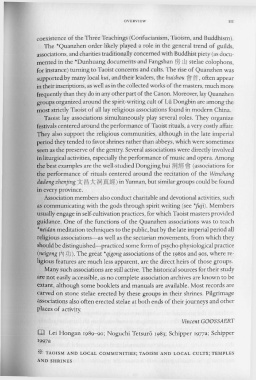Page 151 - The Encyclopedia of Taoism v1_A-L
P. 151
OV E RVI EW III
coexistence of the Three Teachings (Confucianism, Taoism, and Buddhism).
The *Quanzhen order likely played a role in the general trend of guilds,
associations, and charities traditionally concerned with Buddhist piety (as docu-
mented in the *Dunhuang documents and Fangshan ffj- ill stelae colophons,
for instance) turning to Taoist concerns and cults. The rise of Quanzhen was
supported by many local hui, and their leaders, the huishou lr§", often appear
in their inscriptions, as well as in the collected works of the masters, much more
frequently than they do in any other part of the Canon. Moreover, lay Quanzhen
groups organized around the spirit-writing cult of Ui Dongbin are among the
most strictly Taoist of all lay religious associations found in modern China.
Taoist lay associations simultaneously play several roles. They organize
festivals centered around the performance of Taoist rituals, a very costly affair.
They also support the religious communities, although in the late imperial
period they tended to favor shrines rather than abbeys, which were sometimes
seen as the preserve of the gentry. Several associations were directly involved
in liturgical activities, especially the performance of music and opera. Among
the best examples are the well-studied Dongjing hui ifnJ ~~ lr (associations for
the performance of rituals centered around the recitation of the Wenchang
dadong zhenjing X 13 *-ifnJ ffiU~) in Yunnan, but similar groups could be found
in every province.
Association members also conduct charitable and devotional activities, such
as communicating with the gods through spirit writing (see *fo.ji). Members
usually engage in self-cultivation practices, for which Taoist masters provided
guidance. One of the functions of the Quanzhen associations was to teach
*neidan meditation techniques to the public, but by the late imperial period all
religious associations-as well as the sectarian movements, from which they
should be distinguished-practiced some form of psycho-physiological practice
(neigong i*J J}]). The great *qigong associations of the 1980s and 90S, where re-
ligious features are much less apparent, are the direct heirs of those groups.
Many such associations are still active. The historical sources for their study
are not easily accessible, as no complete association archives are known to be
extant, although some booklets and manuals are available. Most records are
carved on stone stelae erected by these groups in their shrines. Pilgrimage
associations also often erected stelae at both ends of their journeys and other
places of activity.
Vincent GOOSSAERT
III Lei Hongan I989-90; Noguchi Tetsuro 1983; Schipper I977a; Schipper
1997a
;:;:: TAOISM AND LOCAL COMMUNITIES; TAOISM AND LOCAL CULTS; TEMPLES
AND SHRINES

